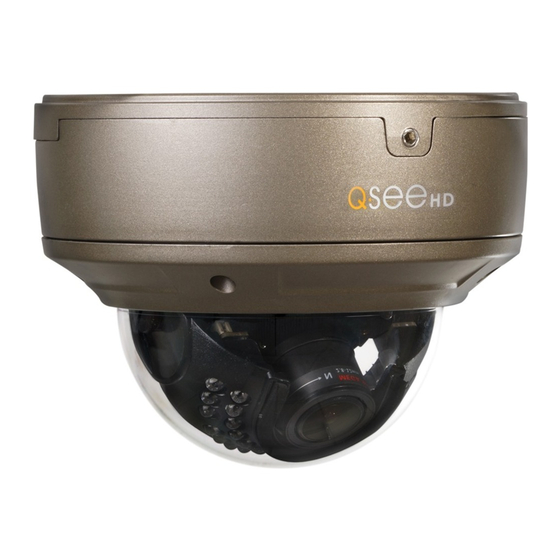
Advertisement
Quick Links
In addition to its video surveillance functions, the QTN8022D is able to accept input
from other devices and either pass their signals back to an NVR, or utilize them to
trigger recording or alert actions when it is being used in a stand-alone role. The
camera can accept a micro SD card up to 64GB, allowing it to record still images
without the need for an NVR.
By using the audio input and output to connect both a microphone and speaker -
and with similar audio equipment on the user's end, two-way communication can
take place. Two alarm sensors can be connected to the alarm block with a single
output to an audible alarm, an external alarm input or to a NVR. When used with an
NVR or on a network, the alarm signal can trigger recording and its signal can be
transmitted via the Cat 5e cable to an NVR.
1
2
# Item
Function
1 Inside camera:
Storage
Up to 64GB memory
Focus,
Adjust camera's zoom and focus
Reset
Reset camera if user is locked out
2 Alarm
2 Alarm inputs 1 Output
3 PT Controls
Connection point for analog pan-tilt platform.
4 Power
For use without POE
5 RJ45 (Ethernet)
For network connectivity, video output and power input
Port
(via POE)
6 HP (Headphones) Audio out - connect to speaker
7 Mic
Input for optional microphone, using included adapter (7a)
7a
3
4
6
5
7
MOUNTING THE CAMERA
The QTN8022D camera is designed to be mounted on the ceiling. The baseplate is
removable to allow for easy installation.
Use the included hexagonal wrench to unscrew
the retaining bolt half-way. This bolt is located on
the front of the camera, above the Q-See logo.
Use the self-adhesive template to locate the
holes for the mounting screws rather than the
baseplate itself to prevent damage. The large
circle on the template marks the ideal position
to drill a hole for the cables if you will be running
them inside the ceiling. The knock-out on the
back of the base can be removed if you intend to
run the cables along the wall, etc.
Once you have drilled the necessary holes, use the included screws and anchors - or
other mounting hardware as needed - to secure the base to the surface.
Connect the cables and ensure that they will not be pinched when the camera is
attached.
Attach the camera body to the base and tighten the retaining bolt.
ADJUSTING THE LENS
The QTN8022D has a lens that can be manually
adjusted between 2.8mm and 12mm. The
2.8mm setting provides a 109° field of view.
The 12mm setting enlarges subjects by
approximately three times compared to the
2.8mm configuration, with the field of view
narrowing to 22°.
The camera is shipped in the 2.8mm position.
To adjust the lens, you will have to first remove
the camera's dome by loosening the four screws
holding the cover in place. The screws should
not be removed from the cover.
Once the cover has been removed, you can
adjust the Focus (a) and zoom (b) using the two
knobs located on the lens body behind the LED
circuit board. You may need to loosen them
by twisting the knob counter-clockwise before
making the adjustments. Do not apply excessive
force to the knobs as they can snap off, leaving
your camera unable to be adjusted.
Instructions continued on other side
QTN8022D
a
b
Advertisement

Summary of Contents for Q-See QTN8022D
- Page 1 QTN8022D In addition to its video surveillance functions, the QTN8022D is able to accept input MOUNTING THE CAMERA from other devices and either pass their signals back to an NVR, or utilize them to The QTN8022D camera is designed to be mounted on the ceiling. The baseplate is trigger recording or alert actions when it is being used in a stand-alone role.
- Page 2 SD CARD be able to monitor the camera’s view to ensure The QTN8022D also has a slot for a Micro SD card (e)which allows the camera to that the image is properly in focus and includes record still images when it is operating on its own network (ie; not directly connected to the entire area that you wish to monitor.
















Need help?
Do you have a question about the QTN8022D and is the answer not in the manual?
Questions and answers